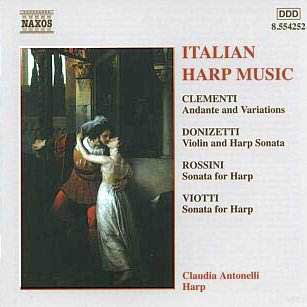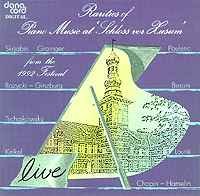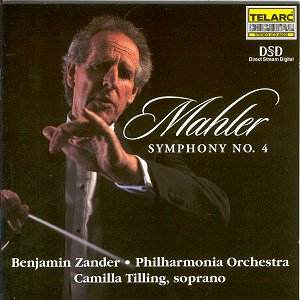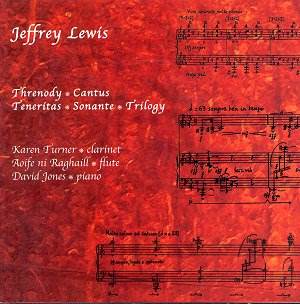 Composer: Muzio Clementi (1752-1832), Giovanni Battista Viotti (1755-1824), Francesco Pollini (1762-1843), Gioachino Rossini (1792-1868), Gaetano Donizetti (1797-1848), Nicolas Charles Bochsa (1789-1856), Marianna Creti de Rocchis (1822?-1890?)
Composer: Muzio Clementi (1752-1832), Giovanni Battista Viotti (1755-1824), Francesco Pollini (1762-1843), Gioachino Rossini (1792-1868), Gaetano Donizetti (1797-1848), Nicolas Charles Bochsa (1789-1856), Marianna Creti de Rocchis (1822?-1890?)
Works: Andante and variations (Clementi), Sonata for Harp (Viotti), Capriccio and aria with variations (Pollini), Theme and variations (Pollini), Allegretto (Rossini), Sonata for Harp (Rossini), Andante and variations for Violin and Harp (Rossini), Sonata for Violin and Harp (Donizetti), Fantasia on Bellini’s ‘I Capuleti e Montecchi’ (Bochsa), Fantasia on Bellini’s ‘Casta Diva’ (Creti de Rocchis)
Performers: Claudia Antonelli (harp), Alberto Ambrosini (violin)
Recording: DDD: recorded in Montepulciano Siena, 18-20 August 1996
Label: NAXOS
This album presents a fascinating exploration of Italian harp music, featuring an array of compositions that reflect both the history of the instrument and the cultural milieu of early 19th-century Italy. The harp, often relegated to a secondary role in orchestral settings, here takes center stage, showcasing its delicate expressiveness through works that span several composers who contributed to the harp repertoire. The selected pieces, primarily from the early 1800s, reveal the harp as a vehicle for melody and decoration, often through a lens of charming simplicity.
Claudia Antonelli’s performance is characterized by a refined approach to the instrument, embracing both the lyrical and technical demands of the repertoire. Her interpretation of Clementi’s “Andante and Variations” highlights a nuanced understanding of phrasing and dynamic contrast, allowing the work’s inherent lyricism to flourish. Antonelli’s ability to illuminate the florid passages while maintaining clarity of line is commendable, particularly in the Viotti Sonata, where she skillfully navigates the interplay between harp and violin, played by Alberto Ambrosini. The two musicians exhibit a collaborative spirit, engaging in a dialogue that is both conversational and virtuosic.
The engineering quality of this recording deserves special mention. Captured with a sensitivity that respects the harp’s ethereal qualities, the sound is both resonant and intimate. Each pluck of the strings is rendered with clarity, allowing the listener to appreciate the instrument’s timbral nuances. While the recording does not shy away from the harp’s more percussive aspects, it also preserves the delicate harmonic overtones that characterize its sound. This balance is particularly effective in the two Bellini-inspired fantasias, where the harp’s ability to convey both melody and harmony is put to the test. Antonelli’s execution in these pieces is both technically proficient and emotionally engaging, creating a captivating auditory experience.
The selection of repertoire is thoughtfully curated, although some works, like Rossini’s brief pieces, feel somewhat insubstantial compared to the more robust offerings from Pollini and Bochsa. The slight nature of these compositions does not detract from the overall enjoyment but does highlight the disparity in the depth of musical material available for the harp at the time. Antonelli’s skill in these lighter works, however, ensures they do not languish in obscurity but rather serve as delightful interludes within the program.
This recording stands out not only for its artistry but also for its historical significance in showcasing lesser-known works for the harp. Antonelli’s performance, paired with the engineering finesse of NAXOS, offers a compelling invitation to rediscover the harp’s lyrical potential. The album is a testament to the enchanting qualities of the instrument and its repertoire, making it a valuable addition to any classical music collection.



